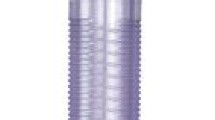Abstract
Background
Although, the vast majority of bariatric procedures worldwide are performed laparoscopically, there is no consensus on the best technique to enter the first trocar, a potentially dangerous maneuver. Three principally different techniques exist: initial pneumoperitoneum by Verres needle, open Hasson technique, and direct placement of an optical trocar. In this nationwide survey, we have studied the presently used technique to place the first trocar and identified any intraabdominal injuries in 2012–2014.
Methods
A questionnaire concerning techniques for placing the first trocar and identified intraabdominal injuries was sent to all 41 centers performing laparoscopic Roux en-Y gastric bypass (LRYGB) in Sweden. Total number of procedures were collected from the national quality registry, Scandinavian Obesity Surgery Registry (SOReg), also searched for reports on intraabdominal injuries.
Results
During the present study period, 17,446 LRYGBs were performed. Twelve intraabdominal injuries (0.07 %) were found: bleedings from the omentum, small bowel mesentery and liver (n = 8), and gastric or small bowel perforation (n = 4). The injuries were evenly distributed between the Veress technique and direct placement of an optical trocar, while no injuries occurred with the Hasson technique. Concerning placement of the first trocar, initial pneumoperitoneum with Veress needle was most common (59 %), followed by direct placement of an optical trocar (30 %). This indicates a switch from 2009–2010 (Veress 45 % and optical trocar 45 %, p < 0.001).
Conclusions
Twelve intraabdominal injuries (0.07 %) were found in this nationwide survey. The most common technique for placing the first trocar had switched from directly placing an optical trocar to prior establishment of pneumoperitoneum.

Similar content being viewed by others
References
Buchwald H, Oien DM. Metabolic/bariatric surgery worldwide 2011. Obes Surg. 2013;23(4):427–36.
Ahmad G, O'Flynn H, Duffy JM, et al. Laparoscopic entry techniques. Cochrane Database Syst Rev. 2012;15:2. Review.
Roy GM, Bazzurini L, Solima E, et al. Safe technique for laparoscopic entry into the abdominal cavity. J Am Assoc Gynecol Laparosc. 2001;8:519–28.
Azevedo JL, Azevedo OC, Miyahira SA, et al. Injuries caused by Veress needle insertion for creation of pneumoperitoneum: a systematic literature review. Surg Endosc. 2009;23:1428–32. Review.
Hasson HM. A modified instrument and method for laparoscopy. Am J Obstet Gynecol. 1971;10:886–7.
Hanney RM, Carmalt HL, Merrett N, et al. Use of the Hasson cannula producing major vascular injury at laparoscopy. Surg Endosc. 1999;13:1238–40.
Sharp HT, Dodson MK, Draper ML, et al. Complications associated with optical-access laparoscopic trocars. Obstet Gynecol. 2002;99:553–5. Review.
Sundbom M, Hedberg J, Wanhainen A, et al. Aortic injuries during laparoscopic gastric bypass for morbid obesity in Sweden 2009–2010: a nationwide survey. Surg Obes Relat Dis. 2014;10(2):203–7.
Sundbom M, Wanhainen A, Hedberg J, et al. Aortic injury—uncommon but severe complication of gastric bypass. Bariatric surgery can cause life-threatening hemorrhage, shown by three case reports. [Swedish]. Lakartidningen. 2011;108:146–9.
Hedenbro JL, Näslund E, Boman L, et al. Formation of the Scandinavian Obesity Surgery Registry. SOReg Obes Surg. 2015;25(10):1893–900.
Scandinavian Obesity Registry (SOReg). Year report 2014, part 1. [Swedish, with summary in English]. Available at http://www.ucr.uu.se/soreg/index.php/arsrapporter. Accessed at 16th of October, 2015.
Deziel DJ, Millikan KW, Economou SG, et al. Complications of laparoscopic cholecystectomy: a national survey of 4,292 hospitals and an analysis of 77,604 cases. Am J Surg. 1993;165:9–14.
Champault G, Cazacu F, Taffinder N. Serious trocar accidents in laparoscopic surgery: a French survey of 103,852 operations. Surg Laparosc Endosc. 1996;6:367–70.
Schäfer M, Lauper M, Krähenbühl L. Trocar and Veress needle injuries during laparoscopy. Surg Endosc. 2001;15(3):275–80.
Llarena NC, Shah AB, Milad MP. Bowel injury in gynecologic laparoscopy: a systematic review. Obstet Gynecol. 2015;125(6):1407–17.
Kosuta M, Palmisano S, Piccinni G, et al. Safety of Veress needle insertion in laparoscopic bariatric surgery. Surg Laparosc Endosc Percutan Tech. 2014;24(1):e1–4.
Zaraca F, Catarci M, Gossetti F, et al. Routine use of open laparoscopy: 1,006 consecutive cases. J Laparoendosc Adv Surg Tech A. 1999;9(1):75–80.
Moberg AC, Petersson U, Montgomery A. An open access technique to create pneumoperitoneum in laparoscopic surgery. Scand J Surg. 2007;96(4):297–300.
Tinelli A, Malvasi A, Istre O, et al. Abdominal access in gynaecological laparoscopy: a comparison between direct optical and blind closed access by Verres needle. Eur J Obstet Gynecol Reprod Biol. 2010;148(2):191–4.
Minaker S, MacPherson C, Hayashi A. Can general surgeons evaluate visceral slide with transabdominal ultrasound to predict safe sites for primary laparoscopic port placement? A prospective study of sonographically naïve operators at a tertiary center. Am J Surg. 2015;209(5):804–8. discussion 808-9.
Vilos GA, Ternamian A, Dempster J, The Society of Obstetricians and Gynaecologists of Canada, et al. Laparoscopic entry: a review of techniques, technologies, and complications. J Obstet Gynaecol Can. 2007;29:433–65. Review.
Author information
Authors and Affiliations
Corresponding author
Ethics declarations
Compliance with Ethical Standards
The survey was approved by the regional ethical review board at Uppsala University, Sweden.
Conflict of Interest
The authors declare that they have no competing interests.
Informed Consent
At baseline visit, patients give informed consent to be included in the Scandinavian Obesity Surgery Registry (SOReg).
Rights and permissions
About this article
Cite this article
Sundbom, M., Ottosson, J. Trocar Injuries in 17,446 Laparoscopic Gastric Bypass—a Nationwide Survey from the Scandinavian Obesity Surgery Registry. OBES SURG 26, 2127–2130 (2016). https://doi.org/10.1007/s11695-016-2080-9
Published:
Issue Date:
DOI: https://doi.org/10.1007/s11695-016-2080-9




